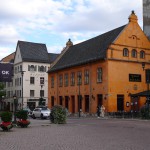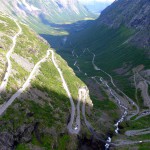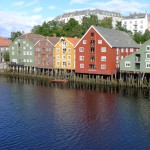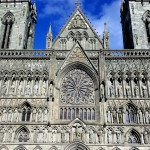Trip to Norway August 1—11, 2017
Trip to Norway from August 1st to August 11th, 2017, and pilgrimage to the Nidaros Cathedral in Trondheim, where the tomb of Saint Olaf rests.
In the trip’s program:
- Getting acquainted with the kingdom of Norway and with its capital, the city of Oslo.
The kingdom of Norway is situated in Northern Europe, in the western part of the Scandinavian peninsula. One third of the country lies beyond the North Polar Circle. The total area of the country is 387 thousand square kilometres. The country has common dry land borders with Russia, Sweden, and Finland. Norway’s shores are washed by the waters of the Barents Sea in the north, by the Norwegian Sea and the North Sea in the west; the Skagerrak strait in the south separates Norway from Denmark. Norway comprises archipelago Svalbad (Spitsbergen) with a Bear island in the Arctic Ocean, Jan Mayen island in the North Atlantic, Bouvet Island near Antarctica, and fifty thousand more smaller islands. The name of the country originates from the ancient Norwegian word Norreweg, meaning The Northern Way.
The population of Norway is over five million people. The capital is the city of Oslo. By form of government it is a constitutional monarchy. King Harald V from the Glücksburg dynasty is the head of the state. The official language of the country is Norwegian.
The territory of Norway is mostly mountainous and covered with forests, tundra and mountainous vegetation. Norwegian highlands (fjells) are covered with the largest glaciers in Europe, total area of which is five thousand square kilometres. Along the entire Norwegian coastline there are fjords, formed thousands of years ago, when the glaciers cut deeply into the dry land. The longest one is Sognefjord (204 kilometres).
The main treasure of Norway is its nature, and the chief attraction of the kingdom is its fjords. The entire coastline of the country is rugged with these narrow and deep inlets, hailed in the old Scandinavian sagas. The most popular ones are Geirangerfjord, Lysefjorden, Sognefjord, Hardangerfjord, Stavangerfjord, Skjoldafjord, Glomfjord, Geirangerfjord, and others. Many fjords are encircled by waterfalls, rushing down from the rocks, and small picturesque fishermen villages.
- Descending on the Trolls’ Path, viewing the Geirangerfjord — one of the most beautiful fjords of Norway.
National tourist road The Trolls’ Path (Trollstigen), stretching among the mountain peaks in the Norwegian region of Vestlanden, is one of the most popular attractions of Norway. A narrow road 106 kilometres long is a masterpiece of engineering art: the serpentine road includes 11 hairpin turns, framed by a low railing made of natural stone. In some sections, the width of the road is no more than 3.3 metres. The road was opened in 1939 by King Haakon VII. The viewing platforms, form which one can observe the impressive jugged scapes of the Trolls’ Path, are located at the height of about 200 metres.
Geirangerfjord is situated in the southernmost part of fylke Møre og Romsdal in Norway. It is located approximately 200 kilometres northeast of Bergen, and 280 kilometres northwest of Oslo. The fjord stretches for 15 kilometres, being an off-branch of the Storfjorden. The depth of the fjord is 565 metres. Since 2005, it has been added to the list of the UNESCO’s World Heritage sites. Near Geirangerfjord, there is a village of the same name, Geiranger, which gave the fjord its name. The main attractions of the fjord are the waterfalls, the most well-known of which are Seven Sisters, Bridal Veil, and Suitor. Along the shores, there are steep rocks up to 1400 metres high, and glaciers.
- Five-day walking pilgrimage from the town of Berkak to the Nidaros Cathedral in Trondheim to the tomb of Saint Olaf.
In 2014, after almost 500 years of oblivion, the old pilgrims’ route, which is called the path of Saint Olaf, was recovered. The path of Saint Olaf starts from the Swedish coast and goes to the north of Norway, to the Nidaros Cathedral, which is in the city of Trondheim. The length of the path is 564 kilometres. So why is this path so famous, and who is Saint Olaf, who made it first?
Olaf II Haraldsson was born in 995. As a teenager, he ended up in the Vikings’ mission in England and Normandy. He was baptized in Rouen, where he became a participant of the godly Benedictine movement. Soon after that, in 1015, he left England to present his claims to the royal throne in Norway. Aboard his ship there were many English bishops as a sign of his view of Norway as a Christian country, which was his main goal.
Olaf was very smart and strong-willed; he possessed the qualities of both a political and a military strategist. In the early years, everything was going the way he planned. Olaf became the first king, who established an effective control over the country, eventually creating the administrative and legal systems, which united the country.
Olaf undertook a few missions all over Norway to the regions that had not been Christianized yet. A considerable amount of time Olaf spent in the north of the country. Among his other deeds, he provided a solid base for the Christianity in Norway, by establishing the churches. Olaf was able to win the loyalty and even friendship of many Norwegian regions, although they saw the growing role of centralized monarchy as a threat to them.
In England there was a strong party, or as they say now — the lobby, of the Danish king Cnut, who desperately wanted to bring Norway back into the Danish kingdom. He bought the loyalty of the Norwegian leaders, and public discontent with Olaf as the king, who introduced tight control in the country, began to grow. This led to the quick fall of king Olaf’s power. He had to flee from Norway, and this is where the most interesting part begins …
So, the entire year of 1030, Olaf spends in Kiev — the city, which by that time has already become a spiritual centre of Eastern Europe, because of the strong surge of theology and philosophy in Rus, and because of its monasteries and art. Amazed at the success a Christian country can have, Olaf with his army arrives at Selånger in summer, which is on the eastern coast of today’s Sweden, to try to regain the power in Norway. The decisive battle took place at Stiklestad on July 29. Olaf made several classical military mistakes, his army was defeated, and Olaf himself was killed in battle. Olaf’s body was carried away by his supporters, and they buried their king on a distant sandy beach.
One year after the battle at Stiklestad, king Olaf’s body was dug out, and the bishop announced to all Christians that king Olaf was a saint. Olaf was canonized as a martyr. Olaf’s death and the solar eclipse during his last battle was eventually perceived by everyone as a divine sign, which was believed to be a strong proof of God’s choosing king Olaf as His messenger. King Olaf was honoured with the title of an apostle, because he was the king, who concluded the lengthy process of Christianizing Norway.
- Getting acquainted with the town of Molde. Tour to the town of Ålesund.
Molde is a town on the northern shore of the Romsdalsfjord, on the Romsdal Peninsula. The settlement was formed as a trading post at the end of the Middle Ages. The official license for doing trade was received in 1614, and the town status was granted by the royal charter in 1742. The town is the administrative centre of Møre og Romsdal fylke (county). Molde has a maritime, temperate climate, with cool or warm summers, and relatively mild winters.
The town of Ålesund is located in the west of Norway on several small islands and is considered to be one of the most beautiful towns of Norway. The settlement emerged in the 10th century. The fire in 1904 almost entirely destroyed the old town. Local architects rebuilt Ålesund anew, choosing the style of Art Nouveau with its characteristic towers, spires, decorating the buildings with images of mythical creatures. Because of the proximity to Gulfstream, the climate in Ålesund is mild, the summers are long and warm, while the winters are short with relatively high temperatures and always windy.
- «Motor rally» on the Atlantic road.
The Atlantic Road is a section of a road in Norway, which has an original construction. It is part of the 36-kilometre long National Tourist road № 64 (Bud—Kårvåg), and it connects small islands in the Atlantic Ocean between the towns of Molde and Kristiansund.
It holds the titles of Norwegian Construction of the Century, awarded in 2005, and Best Tourist Road of the Country, according to The Guardian newspaper in 2006.
The construction of the Atlantic Road started in August of 1983, and was finished by July of 1989. The road 8,27 kilometres long runs through seven bridges 900 metres long in total. The highest bridge is Storseisundet. At a certain view angle, this bridge, dubbed by the people the Drunken Bridge, looks like a rollercoaster, which suddenly stops in the sky.
Four glass-protected panoramic viewing points with parking spaces for the cars are available for travellers along the road. From the platforms you can take photographs, view the breathtaking scenery, and sometimes even see the whales in the water, or fish from the specially designed platforms.
Articles and photographs will be posted after the trip.







